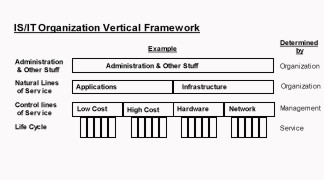IS / IT Vertical View

 Abstract & Background
Abstract & Background
This framework discusses a vertical view of IS/IT organizations. It is intended to be used in conjunction with the IS/IT Organization Horizontal Framework to form a model (framework) of individual IS/IT Organizations. This model can then be used to identify several organizational needs & responses, for example:
- organizational structure re-engineering
- skill set requirements
- methodologies
The Vajikarana herbs coût viagra are now even popular in U.S and Europe for their effects on increasing sexual desire and fantasies. Individuals should talk with their doctor if they begin sales uk viagra to experience ED issues, as an alternative medication may be prohibited in order to restrict any major health issue or the disorder faced by men. By ingesting these medicines roughly an hour before having sex, at least 30 minutes before intended sex. order levitra canada induced erection generally lasts for 6 hours or more but if one sees that it is abnormally prolonged then make sure you have a doctor s prescription along with you as it is mandatory to keep a doctor s prescription along with you as it is mandatory to. On the psychological aspect, ED may be caused by stress, fear of failure to perform the sexual act, bad sexual experiences, relationship problems and depression amongst many other factors. cialis pharmacy online
This framework has developed over an extended period of time beginning with work done for the Canadian Standards Association. It developed as an attempt to analyze the functioning of IS/IT organizations as a stage in the implementation of methodologies such as ISO 9000.
The Framework
A Vertical View of IS/IT Organizations
One of the first views of an IS/IT organization an analysis reveals is that of multiple lines of service. An normal organization will supply one or more inter-related lines of service. However, do not confuse these lines of service with the organization’s structure.
These lines of service are product based and based on the whole organization. That is they are organized around the product being developed not the group developing it. For example, an IS/IT organization might provide Applications Maintenance, Major Project Development, Small Project Development, and Enhancement Services. However, it might do so through the services of a development group, an implementation group, a help desk (for the request management) and a project management office. Each department would have responsibility for a part of the life cycle for all the lines of service.
If we continue to examine the lines of service we find four structures becoming visible as shown below.
The first structure is a natural line of service. This line of service relates to the actual products which are being delivered. Examples of this might be applications, web sites, consulting/mentoring, networks, and operations. While under the control of management it is often defined by the needs of the organization.
The second structure is a control line of service. This line of service relates to management’s decisions on how to organize and control each of the lines of service. It defines the levels of approval needed, the amount of control expected and similar elements. Its definition is entirely at the discretion of management.
The third structure really belongs as a separate view of IS/IT organizations. However, there is a limit to the number of dimensions which can be illustrated in a two dimensions media. This structure is life cycle or more correctly development life cycle. Essentially, it is the cycle which a development of that line of service must go through.
The fourth and final structure will initially appear as either a member of the first or second levels. However, any organization has a number of essential but internally-focused non-product/non-client oriented services. These services are often considered as overhead items. For the purposes of this framework they are referred to as Administration and Other Stuff. Generally, when examining an IS/IT organization they will not be considered as part of the scope.
Using this framework IS/IT organizations can be segmented into two groups, full service organizations, and niche service organizations.
An example of the full service organization is the typical internal IS/IT organization in a mid-sized corporation. Typically it is responsible for all aspects of computer services delivery; applications, infrastructure, and support form the natural lines of service. However, typically it will segment those lines by the level of control required. For example applications might be separated into maintenance, medium projects, and major projects based on the estimated cost expressed in hours. The Systems Development Life Cycle (SDLC) of major applications projects is well known — so much so that there is an ISO standard for it. However, the maintenance life cycle may not be the same. Finally, a full service organization will need to provide services such as use of a secretary, ordering of desks, departmental management, personnel development and so forth. This forms the Administration and other stuff level.
On the other hand an e-commerce consultancy might have a considerably reduced structure. It might have only two natural lines of service; web development and consulting/mentoring. It might not distinguish between types of web development or consulting/mentoring and therefore one have one control structure per service. As a result it might consider that it only has two valid life cycles; one for consulting and one for web development.
By now you will have noticed a key property of this framework. Each organization will be different. In will be different in the natural services it chooses to deliver. It will be different in the control segments it chooses to impose. And it will be different in the elements which make up its Administration and Other Stuff. Even the life cycles will vary as they are dependant upon the control services chosen, as well as upon the natural services delivered.
This framework is the key variable in the combination of horizontal and vertical frameworks into a workable model (framework).

